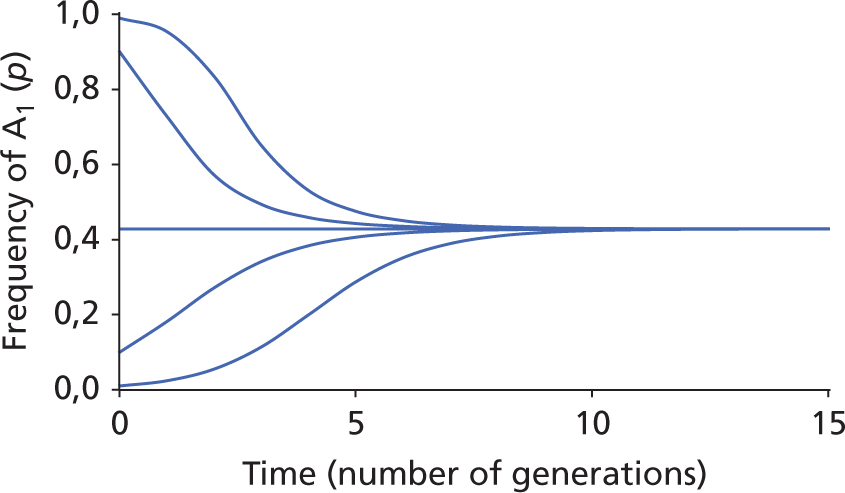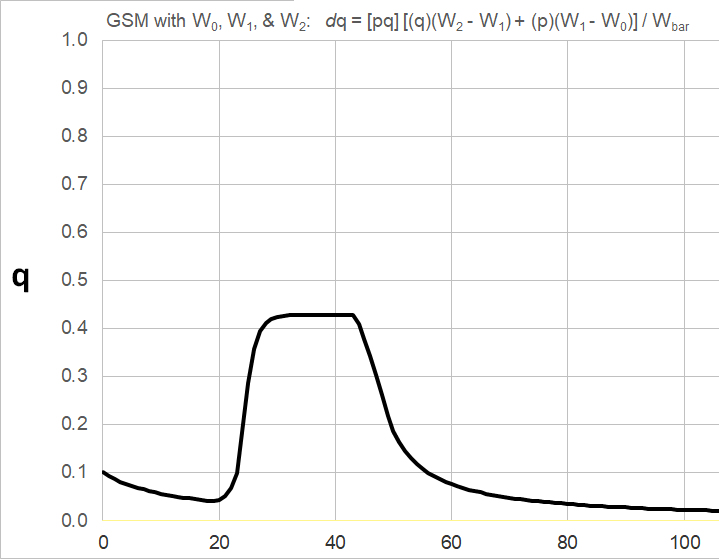

Change in frequency
of A1 in the case of heterozygote
advantage
W11 = 0.2, W12 = 1.0,
W22 = 0.4
Heterozygote advantage occurs when the
fitness of the heterozygous genotype is superior to that of
either homozygote. For the initial values of f(A1)
= 0.001, 0.1, 0.9, 0.999, as shown, p will
converge rapidly on an equilibrium
value (![]() : read "p hat")
where
: read "p hat")
where ![]() p
= 0.0. The equilibrium is calculated as
p
= 0.0. The equilibrium is calculated as ![]() = (1 - W22)
/ (2 - [W11 + W22]),
provided the fitness of the heterozygote has
been normalized as W12 =
1.0. In this case,
= (1 - W22)
/ (2 - [W11 + W22]),
provided the fitness of the heterozygote has
been normalized as W12 =
1.0. In this case, ![]() = (1.0 -
0.4) / (2 - (0.2 + 0.4)) = (0.6 / 1.4) = 0.428571428571
= 0.43 as shown.
= (1.0 -
0.4) / (2 - (0.2 + 0.4)) = (0.6 / 1.4) = 0.428571428571
= 0.43 as shown.
In terms of selection coefficients s1 and s2 against
the A1A1
and A2A2
genotypes, respectively, ![]() = s2 / (s1
+ s2), again
provided the fitness of the heterozygote has been normalized
to 1. In this case, s1
= (1 - W11) = (1.0 -
0.2) = 0.8
and s2 =
(1 - W22) = (1.0 - 0.4) = 0.6. Then s2
/ (s1 + s2)
= (0.6) / (0.8 + 0.6) = (0.6 /
1.4) = 0.43 as before.
= s2 / (s1
+ s2), again
provided the fitness of the heterozygote has been normalized
to 1. In this case, s1
= (1 - W11) = (1.0 -
0.2) = 0.8
and s2 =
(1 - W22) = (1.0 - 0.4) = 0.6. Then s2
/ (s1 + s2)
= (0.6) / (0.8 + 0.6) = (0.6 /
1.4) = 0.43 as before.
In both cases, note that the
numerator for calculation of ![]() of the A1
allele involves the fitness expression for the alternative A2
allele. The more typical calculation of
of the A1
allele involves the fitness expression for the alternative A2
allele. The more typical calculation of![]() thus
uses the expression for the A1
allele.
thus
uses the expression for the A1
allele.
The example shows the behavior
of f(A1)
= q under changing selection. At t = 0, A1
is under directional selection and decreases to q =
0.05 after 20 generations. At t = 20, the selection
environment shifts to that shown above, and q = 0.43
as predicted after about 10 generations. Return to
directional selection at t = 40 decreases q to the
initial value at about t = 55, and the decrease
continues thereafter, with the same slope.